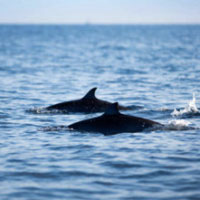 Harbor branch study traces life of dolphin
Harbor branch study traces life of dolphin
STORY BY SUE COCKING (Week of September 24, 2020)
A research report co-authored by a Harbor Branch scientist sheds new light on the fatal problem of bottlenose dolphins becoming entangled in fishing gear in the Indian River Lagoon.
What began as a feel-good story about researchers freeing a dolphin calf from a fishing net near Vero in 2015 came to a sad end two years later when rescuers recovered the young animal’s badly-battered and emaciated body off Fort Pierce – victim of repeated encounters with fishermen and boats.
Scientists say more than 1,000 bottlenose dolphins live in the 156-mile-long lagoon and tend to hang out in the same areas year after year. They frequent spots favored by recreational and commercial fishers, hoping to score an easy meal from people’s fishing lines and nets – a factor in more than 50 dolphin rescues and disentanglements in the waters of Indian River, St. Lucie and Martin counties since 1999.
The travails the dolphin calf suffered in its short life are the subject of a scientific study of the entire event from rescue to postmortem co-authored by Harbor Branch Oceanographic Institute assistant research professor/clinical veterinarian Dr. Annie Page-Karjian in BMC Veterinary Research.
The scientists who disentangled the dolphin were able to follow its progress over a two-year span.
“Even though the disentanglement was considered a success, it only lived two more years and it ultimately had more interactions with fishing gear that contributed to its death,” Page-Karjian said.
“Usually we say if you see dolphins where you are fishing, it’s best if you reel in your line and go somewhere else,” she said.




